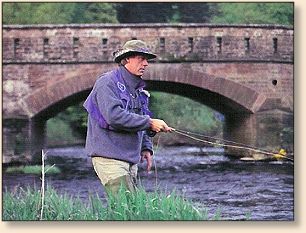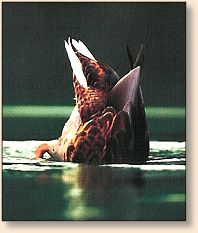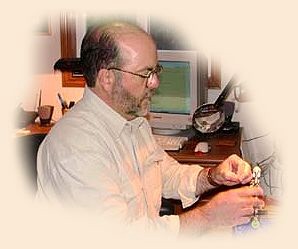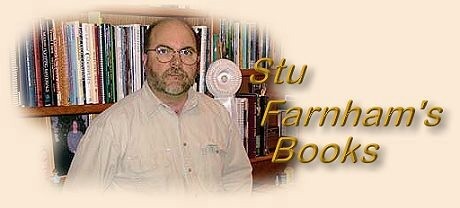|
The Internet is a powerful resource. It provides us instant
access to information, and brings us together via email,
bulletin boards, chat rooms, and instant messaging. FAOL
is a wonderful example of the Internet at its best. The Internet,
however, will never replace the printed page.
I've loved books and fishing since my youngest years, although
I did not start fly fishing until 1993. This column will give
me an opportunity to share reviews of some of my favorite fly
fishing and tying books (and some that are not such favorites)
with my friends here at FAOL. My library reflects my tastes
and interests, and so will this column. It will be heavily
slanted towards cold water fishing and tying for trout and
steelhead, and won't touch much on areas of which I know little,
such as warm or salt water fishing.
I hope that these reviews will motivate some of you to pick up
a good book, on this or any subject, and read.
~ Stu Farnham
Tying Flies With CDC:
The Flyfisher's Miracle Feather
 Tying Flies With CDC: The Flyfisher's Miracle Feather
Tying Flies With CDC: The Flyfisher's Miracle Feather
by Leon Links
Hardcover: 160 pages
Publisher: Stackpole Books
ISBN: 0811700399 (2002)
CDC, that wonderful feather from around the preen gland
of waterfowl, has been used for fly tying in Europe since
the 1920s. The earliest reference I can find in book form
in North America is in Darrel Martin's excellent 1987
Fly Tying Methods. I've heard of earlier
articles in fly fishing magazines in the US, but have
not been able to verify those references. The feathers'
utility is variously attributed to oil from the preen
gland, or bubbles trapped by the feathers' unique
structure. I won't weigh in with an opinion as to cause,
but CDC is a favorite material of mine for its very
lifelike appearance. It is just plain buggy.

Dutch fly fisher and tier Leon Links has written a book
about this remarkable material. Leon begins by explaining
those characteristics that appeal to him in CDC as a tying
material: light weight for delicate presentation; low air
resistance to aid in casting, natural color and transparency,
and buoyancy. Citing research by Marc Petitjean, he traces
the history of CDC's application in fly tying to the Swiss
town of Courfaivre in the 1920s in flies tied by Maximillian
Joset and later by his protégé Louis Veya, and to flies tied
commercially in the town of Vallorbe by Charles Bickel.
The application of CDC was taken up by the French, and advanced
by such well-known tiers as Henri Bresson, Aime Devaux and
r. Jean-Paul Pequegnot. Instructions for tying Devaux's
evolution of the original Swiss moustique patterns, and
Pequegnot's Assassine are included.
Following the historical introduction is a chapter on the
feathers themselves. Links describes how the various types
of CDC feather can be applied as hackle, as whole feathers
or in bunches, in spinning loops, as dubbing, and twisted
into a rope to form the body of a fly. Information is also
included on the structure and natural colors of CDC feathers,
as well as the challenges associated with dyeing CDC without
destroying its lifelike characteristics.
 The rest of the book is devoted to the use of CDC by noted fly
tiers, starting with CDC pioneers Marjan Fratnik, developer of
the simple but effective F Fly, Gerhard Laible and his
dubbing-loop technique for using CDC, and Marc Petitjean,
ho applies CDC to a hook in a number of creative and
useful manners.
The rest of the book is devoted to the use of CDC by noted fly
tiers, starting with CDC pioneers Marjan Fratnik, developer of
the simple but effective F Fly, Gerhard Laible and his
dubbing-loop technique for using CDC, and Marc Petitjean,
ho applies CDC to a hook in a number of creative and
useful manners.
Leon's survey of CDC tiers and their flies continues with
the work of a number of well - and lesser-known tiers: bead
head pioneer Theo Bakelaar, Hans Van Klinken of Klinkhamer
fame, Italians Paolo Jaia and Gig Goldoni, Clive Perkins
from the UK, and Americans Rene Harrop and Marvin Nolte
are among those whose CDC patterns are included in the
book. Links also includes a section of his own patterns.
There is also a short section of fishing CDC flies. The main
caution here is never to treat CDC feathers with conventional
floatants, as these will mat the feathers and kill their
lifelike movement. CDC flies, which are waterlogged or
slimed can be dried with a patch of amadou and refreshed
with any of the various crystal desiccants available
commercially.
This specialized book is a fine addition to the intermediate
or advanced fly tier's library. For the North American tier,
it provides a refreshing look at some of the patterns and
techniques used elsewhere in the fly fishing world ~ Stu Farnham
About Stu
 Stu Farnham is a New Englander by birth, who was transplanted to
and put down roots in Oregon in the early 1990s, now residing in
the Seattle area. A software engineering manager by vocation,
he can be found in his spare time chasing trout and steelhead
in the rivers of the Pacific Northwest, chasing his four Gordon
Setters (who in turn are chasing chukar), tying flies, reading,
or working on his website. Colleen, his long suffering wife of
28 years, is a professionally trained personal chef.
Stu Farnham is a New Englander by birth, who was transplanted to
and put down roots in Oregon in the early 1990s, now residing in
the Seattle area. A software engineering manager by vocation,
he can be found in his spare time chasing trout and steelhead
in the rivers of the Pacific Northwest, chasing his four Gordon
Setters (who in turn are chasing chukar), tying flies, reading,
or working on his website. Colleen, his long suffering wife of
28 years, is a professionally trained personal chef.
|



